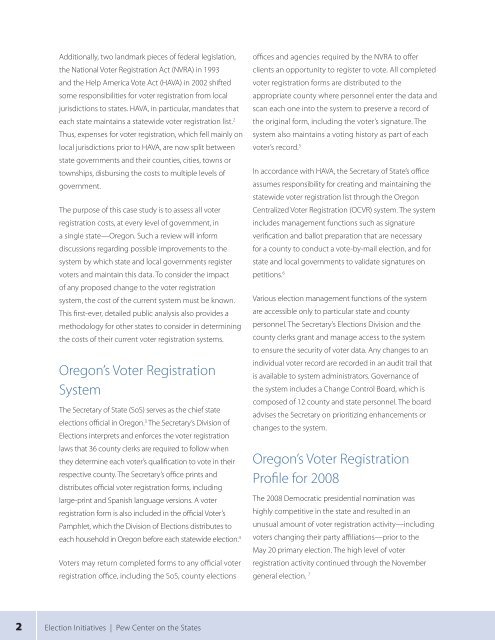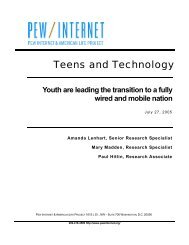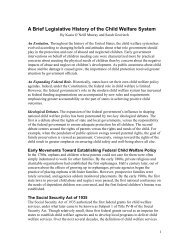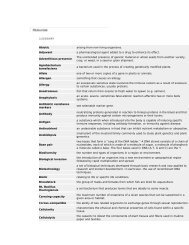The Real Cost of Voter Registration: An Oregon Case Study
The Real Cost of Voter Registration: An Oregon Case Study
The Real Cost of Voter Registration: An Oregon Case Study
Create successful ePaper yourself
Turn your PDF publications into a flip-book with our unique Google optimized e-Paper software.
Additionally, two landmark pieces <strong>of</strong> federal legislation,<br />
the National <strong>Voter</strong> <strong>Registration</strong> Act (NVRA) in 1993<br />
and the Help America Vote Act (HAVA) in 2002 shifted<br />
some responsibilities for voter registration from local<br />
jurisdictions to states. HAVA, in particular, mandates that<br />
each state maintains a statewide voter registration list. 2<br />
Thus, expenses for voter registration, which fell mainly on<br />
local jurisdictions prior to HAVA, are now split between<br />
state governments and their counties, cities, towns or<br />
townships, disbursing the costs to multiple levels <strong>of</strong><br />
government.<br />
<strong>The</strong> purpose <strong>of</strong> this case study is to assess all voter<br />
registration costs, at every level <strong>of</strong> government, in<br />
a single state—<strong>Oregon</strong>. Such a review will inform<br />
discussions regarding possible improvements to the<br />
system by which state and local governments register<br />
voters and maintain this data. To consider the impact<br />
<strong>of</strong> any proposed change to the voter registration<br />
system, the cost <strong>of</strong> the current system must be known.<br />
This first-ever, detailed public analysis also provides a<br />
methodology for other states to consider in determining<br />
the costs <strong>of</strong> their current voter registration systems.<br />
<strong>Oregon</strong>’s <strong>Voter</strong> <strong>Registration</strong><br />
System<br />
<strong>The</strong> Secretary <strong>of</strong> State (SoS) serves as the chief state<br />
elections <strong>of</strong>ficial in <strong>Oregon</strong>. 3 <strong>The</strong> Secretary’s Division <strong>of</strong><br />
Elections interprets and enforces the voter registration<br />
laws that 36 county clerks are required to follow when<br />
they determine each voter’s qualification to vote in their<br />
respective county. <strong>The</strong> Secretary’s <strong>of</strong>fice prints and<br />
distributes <strong>of</strong>ficial voter registration forms, including<br />
large-print and Spanish language versions. A voter<br />
registration form is also included in the <strong>of</strong>ficial <strong>Voter</strong>’s<br />
Pamphlet, which the Division <strong>of</strong> Elections distributes to<br />
each household in <strong>Oregon</strong> before each statewide election. 4<br />
<strong>Voter</strong>s may return completed forms to any <strong>of</strong>ficial voter<br />
registration <strong>of</strong>fice, including the SoS, county elections<br />
<strong>of</strong>fices and agencies required by the NVRA to <strong>of</strong>fer<br />
clients an opportunity to register to vote. All completed<br />
voter registration forms are distributed to the<br />
appropriate county where personnel enter the data and<br />
scan each one into the system to preserve a record <strong>of</strong><br />
the original form, including the voter’s signature. <strong>The</strong><br />
system also maintains a voting history as part <strong>of</strong> each<br />
voter’s record. 5<br />
In accordance with HAVA, the Secretary <strong>of</strong> State’s <strong>of</strong>fice<br />
assumes responsibility for creating and maintaining the<br />
statewide voter registration list through the <strong>Oregon</strong><br />
Centralized <strong>Voter</strong> <strong>Registration</strong> (OCVR) system. <strong>The</strong> system<br />
includes management functions such as signature<br />
verification and ballot preparation that are necessary<br />
for a county to conduct a vote-by-mail election, and for<br />
state and local governments to validate signatures on<br />
petitions. 6<br />
Various election management functions <strong>of</strong> the system<br />
are accessible only to particular state and county<br />
personnel. <strong>The</strong> Secretary’s Elections Division and the<br />
county clerks grant and manage access to the system<br />
to ensure the security <strong>of</strong> voter data. <strong>An</strong>y changes to an<br />
individual voter record are recorded in an audit trail that<br />
is available to system administrators. Governance <strong>of</strong><br />
the system includes a Change Control Board, which is<br />
composed <strong>of</strong> 12 county and state personnel. <strong>The</strong> board<br />
advises the Secretary on prioritizing enhancements or<br />
changes to the system.<br />
<strong>Oregon</strong>’s <strong>Voter</strong> <strong>Registration</strong><br />
Pr<strong>of</strong>ile for 2008<br />
<strong>The</strong> 2008 Democratic presidential nomination was<br />
highly competitive in the state and resulted in an<br />
unusual amount <strong>of</strong> voter registration activity—including<br />
voters changing their party affiliations—prior to the<br />
May 20 primary election. <strong>The</strong> high level <strong>of</strong> voter<br />
registration activity continued through the November<br />
general election. 7<br />
2 Election Initiatives | Pew Center on the States
















